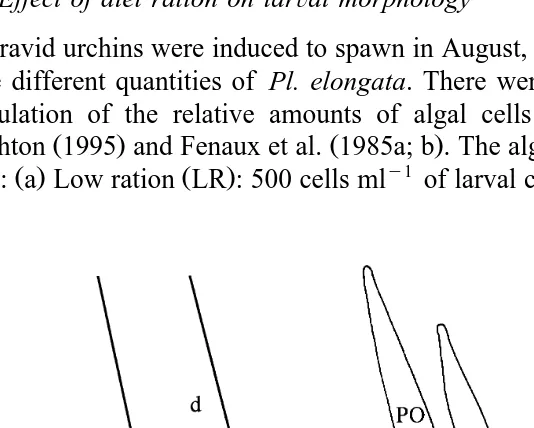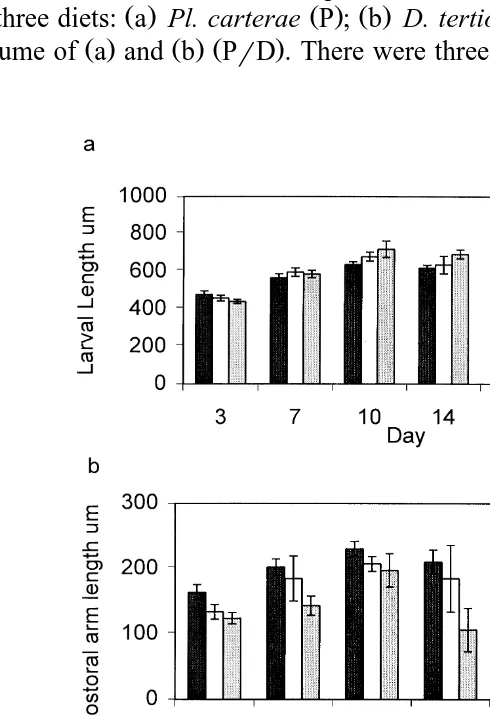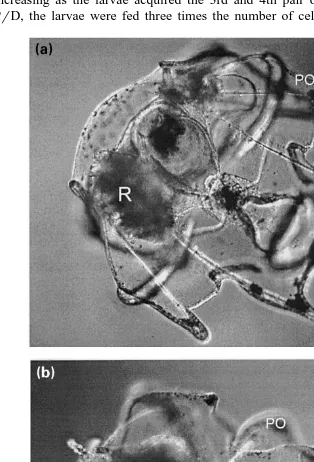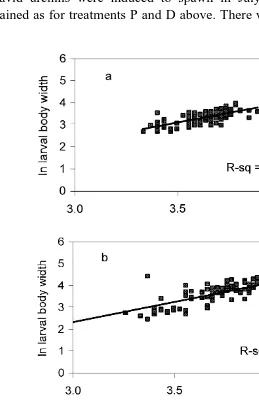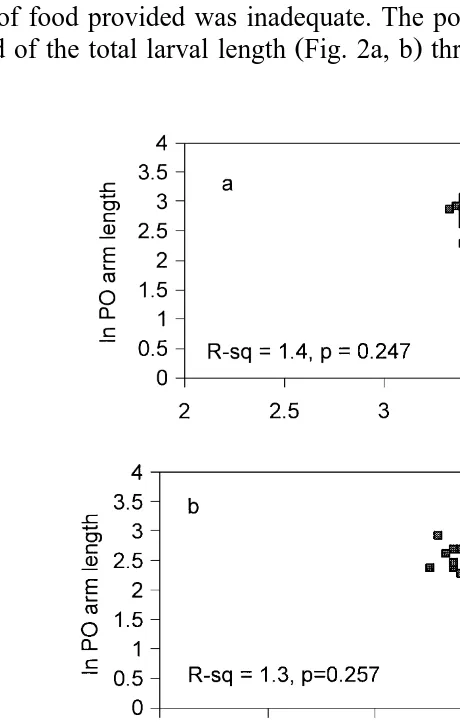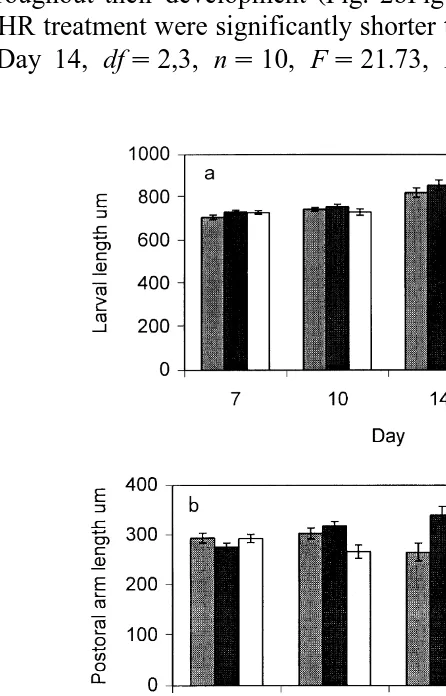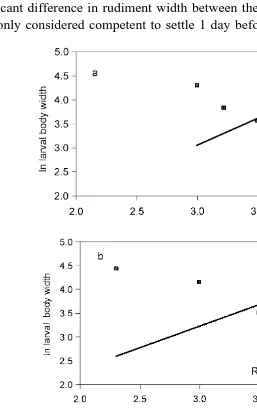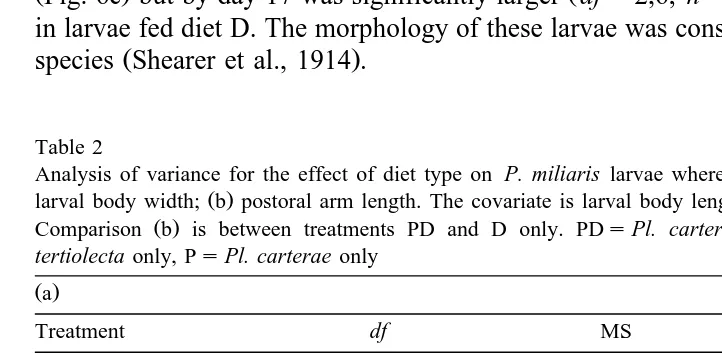www.elsevier.nlrlocateraqua-online
Morphology and survivorship of larval
ž
/ ž
Psammechinus miliaris Gmelin Echinodermata:
/
Echinoidea in response to varying food quantity
and quality
Maeve S. Kelly
), Amanda J. Hunter, Claire L. Scholfield,
J. Douglas McKenzie
Scottish Association for Marine Science, P.O. Box 3, Oban, Scotland, PA34 4AD, UK
Accepted 22 August 1999
Abstract
Experiments were conducted with the aim of defining the optimal culture conditions for
Psammechinus miliaris larvae. Larval response to varying food rations of the microalgae, Pleurocrysis elongata, was assessed by recording the morphological parameters of developing
Ž y1.
larvae. Larvae on a high ration 4000 cells ml showed an extreme reduction in postoral arm length and were unable to maintain their position in the water column. Larvae fed an optimal
Ž y1 .
ration 1500–4000 cells ml according to developmental stage displayed a more typical
Ž y1.
morphology, whereas larvae fed a low ration 500 cells ml failed to develop to metamorphosis. Survivorship of the larvae to metamorphosis was at best 61%. Larval response to various diet types was measured both in terms of the larval morphology, survivorship during metamorphosis and growth over the post-larval period. The microalgae, Dunaliella tertiolecta, produced more morphologically typical larvae and gave better results in terms of survivorship at metamorphosis
Ž65.8% than Pl. carterae 48.2% . The resulting juveniles, measured at 10 days post-settlement,. Ž .
were also significantly larger when the larvae had been fed D. tertiolecta. Survivorship over the post-larval period was more consistent when larvae were provided with a substrate coated with a natural biofilm compared with a substrate coated with the microalgae, Tetraselmis suecica. The
)Corresponding author. Tel.:q44-1631-567833; fax:q44-1631-565518.
0044-8486r00r$ - see front matterq2000 Elsevier Science B.V. All rights reserved.
Ž .
data suggest that it is possible to produce large numbers of juvenile P. miliaris using these methods.q2000 Elsevier Science B.V. All rights reserved.
Keywords: Psammechinus miliaris; Microalgae; Survivorship; Morphology; Larvae; Echinoid; Culture
1. Introduction
Sea urchin roe is a luxury food product for which there is a large, under-supplied
Ž .
market in Europe and in the Far East Keesing and Hall, 1998 . The decline of natural sea urchin stocks has increased efforts to develop methods for successful cultivation of
Ž
edible species Fernandez and Caltagirone, 1994; de Jong-Westman et al., 1995;
.
Grosjean et al., 1998 . Some research effort has focused on gonad enhancement of fished or ranched stocks, but as these programmes do nothing to alleviate the pressure on wild stocks, there is need for fully integrated culture systems. This will then permit the selection of brood stock for the development of strains of urchins selected for fast growth, gonad yield and disease resistance.
Of the edible species of echinoids found on the west coast of Scotland,
Psammechi-Ž .
nus miliaris Gmelin is the one that is considered to have the greatest potential as an
Ž .
aquaculture species Kelly et al., 1998a,b . Recent research has shown that this sea
Ž .
urchin grows rapidly both somatic and gonadal in polyculture with the Atlantic salmon
Ž .
Salmo salar Kelly et al., 1998a,b and that its growth rates also respond rapidly to
Ž .
extruded formulated feeds Cook et al., 1998 . However, defining the parameters for large-scale culture of larvae through metamorphosis to the juvenile stage is an additional prerequisite of any echinoculture industry.
As the husbandry effort during the larval life span is relatively high, there is an obvious economic advantage to minimising the time to metamorphosis as well as maximising survivorship at metamorphosis. It is well-documented that both the type and
Ž .
quantity of food supplied affect the duration of the larval life span. Hinegardner 1969 investigated a range of microalgal species and determined those that best supported successful development to metamorphosis for five species of echinoids. The microalgae
Ž . Ž .
Pleurocrysis carterae Braarud and Fagerland formerly Hymenomonas carterae and
Ž . Ž .
Pl. elongata Droop formerly H. elongata , and the diatom Phaeodactylum
tricornu-tum Bohlin have each been used to successfully raise larvae of the edible urchin
Ž . Ž
Paracentrotus liÕidus Lamarck to the point of metamorphosis Fenaux et al., 1985a,
.
1988; Leighton, 1995; Grosjean et al., 1996 . Microalgae that facilitate the larval development in the commercially important echinoids Strongylocentrotus
droebachien-Ž . Ž . Ž
sis Muller and Loxechinus albus Molina have also been determined Gonzalez et al.,
¨
. Ž .
1987; Hart and Scheibling, 1988 . Leighton 1995 used Pl. carterae to raise P. miliaris larvae to the stage where they were competent to metamorphose, but noted that it may not be the optimum larval diet for this species.
The morphometric changes echinoplutei undergo during the course of larval
develop-Ž .
ment have important functional consequences as form shape is related to feeding
Ž .
ŽStrathmann, 1971; Hart, 1991 . Therefore, growing larvae must increase the ciliated.
band length in order to increase the clearance rates of suspended microalgae and to
Ž
maintain their feeding capability relative to metabolic demand McEdward, 1984;
.
Strathmann et al., 1992 . Ciliated band length is increased by increasing arm length and by the development of additional pairs of larval arms.
Ž .
McEdward 1984 estimated that the larval arms carried, on average over the larval
Ž .
lifespan, 68% of the ciliated band in Dendraster excentricus Eschscholtz . The remaining portion of the ciliated band was carried near the arm bases and across the
Ž
body surface. Hence, recording parameters that describe larval morphology e.g., arm
.
length and body width during development is a useful method for assessing larval response to a particular diet ration or type.
Immediately post-metamorphosis, the young urchin consists of the ventral half of the
Ž .
test and an undifferentiated mass of soft tissue Hinegardner, 1969 . At this stage, it lacks a digestive tract and is more properly referred to as a post-larvae. In P. miliaris,
Ž .
the digestive tract is formed after 5–7 days Leighton, 1995 and the juvenile urchin is then complete and ready to feed. Therefore, recording survivorship after the post-larval stage is completed and the juvenile is feeding exotrophically gives a better indication of likely production rates in cultivation systems.
The experiments described here examine the effect of varying both diet ration and type on larval morphology with the aim of designing a system to optimise the production of P. miliaris larvae. The time to settlement, survivorship at metamorphosis and survivorship over the post-larval period on different substrates were recorded.
2. Materials and methods
2.1. General techniques
Ž .
The larval culture methods were based on those of Fenaux et al. 1985a; b and
Ž .
Leighton 1995 for the production of Pa. liÕidus.
Broodstock urchins were collected from local wild populations, maintained in seawater aquaria and fed the macroalgae Laminaria saccharina for approximately 4 months prior to spawning. Gravid urchins were induced to spawn by injection of 0.5 M KCl into the haemocoel via the peristomal membrane. Males and females were kept in individual bowls and the extruded gametes collected by pipette. The eggs were trans-ferred to a 2-l beaker of 5-mm filtered seawater. Sufficient eggs were placed in the bottom of the fertilisation beaker to form a monolayer and 1–2 ml of diluted sperm were then added. After 24 h the swimming blastulae were carefully decanted and evenly distributed into 60-l food-grade polyethylene bins containing 5-mm filtered seawater. The larval cultures were maintained at 178C, aerated and under a photoperiod regime of 16 h light daily. Initially, the larval density was 1 mly1.
On alternate days, the cultures were siphoned onto a 40-mm sieve, and the culture bins were drained, cleaned, and refilled with fresh filtered seawater. The larvae were
Ž .
Ž .
Culture Collection of Algae and Protozoa CCAP : Pl. elongata CCAP 961r3, Pl.
carterae CCAP 961r2 and Dunaliella tertiolecta Butcher CCAP 19r6B.
The microalgae were grown in semi-continuous batch culture, in autoclaved seawater
Ž .
enriched with Walne medium Coutteau, 1996 and under continuous fluorescent illumination. Algal cell density was calculated from haemocytometer counts.
The density of the larvae in the culture and the morphometric parameters, larval
Ž .
length, larval body length, larval width, postoral arm length and rudiment length Fig. 1 were measured at intervals throughout the larval life. The ratio of body length to width was used to describe body shape independently of postoral arm length. The ratio of postoral arm length to larval body length was used as a size-independent measure of
Ž .
larval shape McEdward, 1984 .
Larvae were considered competent to settle when the spines and tube feet were clearly visible in the rudiment. Larvae were tested for competency to settle by presenting them with a substrate that was either conditioned with a natural biofilm of marine
Ž .
bacteria, algae and diatoms Hinegardner, 1969 or coated with the algae Tetraselmis
suecica, which is commonly used to provide a biofilm in commercial hatcheries.
2.2. Effect of diet ration on larÕal morphology
Gravid urchins were induced to spawn in August, 1997. The resulting larvae were fed three different quantities of Pl. elongata. There were two replicates of each treatment. Calculation of the relative amounts of algal cells used was based on the work of
Ž . Ž .
Leighton 1995 and Fenaux et al. 1985a; b . The algal cell density in the larval cultures
Ž . Ž . y1
were: a Low ration LR : 500 cells ml of larval culture per day throughout the larval
Ž . Ž . Ž .
Fig. 1. Measurements recorded on P. miliaris larvae. a Larval length, b larval body length, c larval body
Ž . Ž .
Ž . Ž . y1
life span; b Optimum ration OR : 1500, 2500 or 4000 cells ml of larval culture depending on whether the larvae had two, three or four pairs of larval arms,
respec-Ž . Ž . y1
tively; c High ration HR : 4000 cells ml of larval culture throughout the larval life span. Larval development was recorded as described above. No attempt was made to quantify survivorship after metamorphosis.
2.3. Effect of diet type on larÕal morphology
Gravid urchins were induced to spawn in June, 1998. The resulting larvae were fed
Ž . Ž . Ž . Ž . Ž .
one of three diets: a Pl. carterae P ; b D. tertiolecta D ; or c a 50:50 mixture by
Ž . Ž . Ž .
cell volume of a and b PrD . There were three replicate cultures of each treatment.
Ž . Ž . Ž .
Fig. 2. P. miliaris larvae. a Total larval length, b postoral arm length and c rudiment width as recorded
Ž . Ž .
throughout the larval life span days . LRslow ration. ORsoptimum ration and HRshigh ration see text .
Ž .
For diet P, the larvae were fed 1000, 3000 or 5000 algal cells mly1, the amount increasing as the larvae acquired the 3rd and 4th pair of larval arms. In diets D and
Ž
PrD, the larvae were fed three times the number of cells of D. tertiolecta a smaller
Ž .
Fig. 3. a and b P. miliaris larvae of varying morphology, illustrating typical development and the arm
Ž . Ž . Ž . Ž .
.
algae than for Pl. carterae to give an equivalent cell volume. Larval morphology was recorded as described above.
2.4. SurÕiÕorship at metamorphosis and oÕer the post-larÕal period
Gravid urchins were induced to spawn in July, 1998. The resulting larvae were maintained as for treatments P and D above. There were three replicate 60-l cultures for
Fig. 4. Regression lines describing relationship between body width and body length of P. miliaris larvae for
Ž . Ž . Ž . Ž .
each treatment. Prior to settlement, polystyrene Petri dishes were conditioned by exposure to seawater for 5 days to allow a natural biofilm to develop. On day 20 of development, three replicate groups of 50 larvae from each of the six larval culture bins were placed in the conditioned Petri dishes in 50 ml of seawater. The number of larvae
Ž .
initiating metamorphosis with tube feet and spines projecting from the larval body was recorded after 24, 48 and 72 h. After 72 h, the three dishes representing each replicate larval culture were securely fixed to the bottom of a 2-l plastic tank. Each tank had a seawater supply and 240-mm plankton netting covering the out-flow, allowing the post-larvae to be maintained in a through-flow system. At 10 days post-settlement, the total number and horizontal test diameter of 30 juvenile urchins from each tank were recorded.
In addition, one D-fed larval culture was selected and a further six replicate groups of 50 larvae removed from it. These larvae were placed in Petri dishes previously coated
Ž . Ž .
with either natural biofilm N or T. suecica T . The number of larvae undergoing metamorphosis was again recorded after 24, 48 and 72 h. After 72 h, each dish was securely fixed to the bottom of a 2-l plastic tank, as described above, and the number of juvenile urchins present recorded at 10 days post-settlement.
2.5. Statistical analysis
The data was nested for normality and homogeneity of variance to ensure compliance with the assumptions of ANOVA. Proportions were arcsine transformed prior to testing
Ž .
for normality. Nested ANOVA Sokal and Rohlf, 1995 was then used to examine difference between treatments on any given sample date. Significant differences between treatments were further defined using Tukey’s test. The relationship between
morpholog-Ž .
ical parameters natural logarithm transformed data was also examined over the
Ž . Ž
duration of the experiment using Analysis of Covariance ANCOVA Sokal and Rohlf,
.
1995 . Prior to ANCOVA, regression analysis was used to demonstrate a significant linear relation between parameters and homogeneity of slope confirmed. All analysis was performed using and Minitab for Windows Version 12.
Table 1
Analysis of variance for the effect of diet ration on body width of P. miliaris larvae. The covariate is larval
Ž
body length. The data are ln transformed. LRslow ration. ORsoptimum ration and HRshigh ration see
.
text
Treatment df MS F-value P
Diet ration 2 0.957 10.93 0.001
Covariate, body length 1 52.463 599.18 0.001
Error 296 0.088
Bonferroni pairwise comparison Difference of means SE of difference P
LR and OR 0.196 0.044 0.0001
LR and HR 0.154 0.042 0.001
3. Results
3.1. Effect of diet ration on larÕal morphology
The different food rations affected larval morphology. The larvae from the LR treatment remained as pluteus larvae for the duration of the experiment and failed to develop the third and fourth pairs of larval arms or the echinorudiment, indicating the amount of food provided was inadequate. The postoral arms represented approximately
Ž .
one-third of the total larval length Fig. 2a, b through larval life.
Fig. 5. Regression lines describing the relationship between postoral arm length and body length of P. miliaris
Ž . Ž . Ž . Ž .
larvae for three diet rations. a LR, low ration; b OR, optimum ration and c HR, high ration see text . There is no significant linear relationship for LR and OR. Regression equation for YHRs8.25y1.60 X.
Ž
The larvae from the OR treatment also retained well-developed larval arms Figs. 2b
. Ž
and 3a . The OR larvae were significantly longer dfs2,3, ns10, Fs10.17, P
-. Ž .
0.001 than those in other treatments Fig. 2a on day 17, the final day of complete measurements before the larvae began to metamorphose. The rudiment was observed to
Ž .
have formed on day 14 Fig. 2c , and the larvae were considered to be competent to settle on day 21.
The larvae from the HR treatment showed a pronounced reduction in larval arm
Ž .
length throughout their development Fig. 2bFig. 3b . The postoral arms of the larvae from the HR treatment were significantly shorter than in the other treatments on days 14
Ž
and 17 Day 14, dfs2,3, ns10, Fs21.73, P-0.001; Day 17, dfs2,3, ns10,
Ž . Ž . Ž .
Fig. 6. P. miliaris larvae. a Total length, b postoral arm length and c rudiment length as recorded
Ž .
throughout the larval life span days . PDsPl. carterae plus D. tertiolecta, DsD. tertiolecta only, PsPl.
Ž .
.
Fs22.66, P-0.001 . The almost complete loss of larval arms adversely affected the swimming capability of these larvae. Unless the aeration in the culture was vigorous, they fell from the water column and died on the floor of the culture bin. The rudiment
Ž . Ž .
developed earlier day 10 Fig. 2c , but by the end of the larval life span there was no significant difference in rudiment width between the OR and HR treatments. HR larvae were only considered competent to settle 1 day before the OR treatment.
Fig. 7. Regression lines describing the relationship between body width and body length of P. miliaris larvae
Ž . Ž . Ž .
There was a significant linear relationship between larval body width and larval body
Ž .
length for all three treatments Fig. 4a, b, c , but there was no significant difference in the slope of the fitted regression lines. ANCOVA using larval body width as the independent variable and larval body length as the covariant showed there were
Ž . Ž .
significant effects of treatment diet ration Table 1 , and the observed changes were not due to, for example, different development rates between treatments. Larvae from the LR treatment had a significantly lower body width:length ratio than larvae from the
Ž .
other two treatments Table 1 . There was no significant difference in body width:length ratio between larvae from the OR and HR treatments.
No significant linear relationship was found for postoral arm length and larval body
Ž .
length for treatments LR and OR Fig. 5a, b . However, a significant linear relationship did exist for postoral arm length and body length in treatment HR, describing the
Ž .
progressive shortening of the larval arms during development Fig. 3b, Fig. 5c .
3.2. Effect of diet type on larÕal morphology
Larvae from all treatments were consistently observed with full stomachs, regardless of diet type. However, diet type also affected larval morphology. Larvae fed diet D were
Ž . Ž .
significantly longer Fig. 6a by day 17 dfs2,6 ns10, Fs7.56, P-0.001 than the larvae from the other treatments and retained longer larval arms than the larvae from the
Ž .
other treatments Fig. 6b . The rudiment was first recorded on day 14 for all three diets
ŽFig. 6c but by day 17 was significantly larger df. Ž s2,6, ns10, Fs3.60, P-0.001.
in larvae fed diet D. The morphology of these larvae was considered to be typical of this
Ž .
species Shearer et al., 1914 .
Table 2
Ž .
Analysis of variance for the effect of diet type on P. miliaris larvae where the independent variable is: a
Ž .
larval body width; b postoral arm length. The covariate is larval body length. The data are ln transformed.
Ž .
Comparison b is between treatments PD and D only. PDsPl. carterae plus D. tertiolecta, DsD. tertiolecta only, PsPl. carterae only
Ž .a
Treatment df MS F-value P
Diet type 2 0.243 3.46 0.033
Covariate, body length 1 18.946 269.5 0.001
Error 356 0.070
Bonferroni pairwise comparison Difference of means SE of difference P
PD and D y0.013 0.034 1.000
PD and P 0.071 0.034 0.120
D and P 0.083 0.034 0.044
Ž . Žb treatments PD and D only.
Treatment df MS F-value P
Diet type 1 0.733 4.23 0.041
Covariate, body length 1 4.067 23.46 0.001
Larvae fed diet P had significantly shorter postoral arms than larvae fed diet D or
Ž .
PrD from day 10 dfs2,6, ns10, Fs6.69, P-0.001 . From day 14, there were significant differences in postoral arm length between all three treatments, larvae fed
Ž .
diet D having the longest and P the shortest Fig. 6b . Larvae fed diet PrD did not show the extreme reduction of postoral arm length seen in larvae from treatment P.
Fig. 8. Regression lines describing relationship between postoral arm length and body length of P. miliaris
Ž . Ž . Ž .
larvae for three different diets. a PD, Pl. carterae and D. tertiolecta; b D, D. tertiolecta and c P, Pl.
There was a significant linear relationship between larval body width and larval body
Ž .
length in all three treatments Fig. 7a, b, c . ANCOVA confirmed homogeneity of slope
Ž .
for all treatments and significant differences between treatments Table 2 ; larvae from treatment D having significantly higher width:length ratios than larvae from treatment P. Significant linear relationships also existed for postoral arm length and larval body
Ž .
length in the three treatments Fig. 8a, b, c . Differences in slope only permitted
Ž .
comparison of treatments PD and D, which were significant Table 2 . Larvae from treatment PD had a higher postoral arm length to body length ratio than larvae from treatment D, reflecting the shorter body length of larvae from the PD treatment.
Survivorship of larvae in each treatment on day 17, expressed as a percentage of the
Ž . Ž .
initial stocking density, were Ps46.0% SEs5.3 , Ds53.8% SEs7.59 and PrD
Ž . Ž
s44.7% SEs3.21 . The values were not significantly different dfs2,6, ns3,
. Fs1.43, Ps0.311 .
3.3. SurÕiÕorship at metamorphosis and oÕer the post-larÕal period
The larvae in the P and D treatments developed similar morphology to that observed
Ž .
in the equivalent treatments of the previous experiments 3.2 . The mean survivorship of larvae in each treatment on day 17, expressed as a percentage of the initial stocking
Ž . Ž .
density, was Ps61.5% SEs8.47 , Ds48.9% SEs4.07 . The values were not
Ž .
significantly different dfs2,6, ns3, Fs1.65, Ps0.268 . Larvae were considered to be competent to metamorphose on day 20 when the replicate batches were transferred to the Petri dishes. The diatom Melosira nummuloides Agardh dominated the natural fouling layer coating the Petri dishes. Metamorphosis was not synchronised for larvae from either treatment P or D. Larvae were observed to initiate metamorphosis over a
Ž .
72-h period from when they were first considered to be competent to settle Table 3 . After 72 h, the larvae from treatment D had metamorphosed in significantly higher numbers than those from treatment P, but after 10 days, there was no significant
Ž .
difference in the number of juveniles between the two treatments Table 3 . However, there was a significant difference in test diameter of the juveniles at this stage, the
Ž Ž . Ž .
juveniles from treatment D being larger test diameter SE Ps440.0 mm 10.2 ,
Ž . .
Ds483.2mm 13.5 dfs1,4 ns30, Fs25.85, P-0.001 .
Table 3
Ž .
Percentage of P. miliaris larvae fed different diets undergoing metamorphosis at 24, 48 and 72 h ns9 and survivorship after 10 days. The larvae were presented with a settlement substrate coated with a natural biofilm. DsD. tertiolecta, PsPl. carterae
Diet 24 h 48 h 72 h 10 days
P 35.5 44.9 48.2 53.5
D 38.4 56.4 65.8 58.4
df 1,16 1,16 1,16 1,16
Error MS 57.9 39.1 48.0 38.1
F 0.16 3.84 7.23 0.71
Table 4
Percentage of P. miliaris larvae undergoing metamorphosis at 24, 48 and 72 h and survivorship after 10 days
Ž . Ž .
when presented with a substrate coated with either a natural biofilm N , or the microalgae T. suecica T ,
ns3
Substrate 24 h 48 h 72 h 10 days
N 65 69.3 79.3 47.33
T 35.3 54.0 79.3 14
df 1,4 1,4 1,4 1,4
Error MS 24.2 28.2 30.8 63.3
F 7.97 3.13 5.89 6.32
P-value 0.048 0.152 0.072 0.06
Larvae presented with plates coated with T. suecica underwent metamorphosis in similar numbers but were observed to be attempting the process in the water column without prior attachment to the substrate with their tube feet. The number of juveniles
Ž .
recorded after 10 days Table 4 did not show significance because of the high variation within the T treatment, the mean survivorships from 50 individuals per dish were per
Ž . Ž .
Ns23.6 SD 4.93 and Ts7.33 SD 10.12 , ns3.
4. Discussion
The larvae of P. miliaris demonstrate considerable plasticity in their morphology in response to varying food rations. Larvae on a low food ration maintained longer postoral arms in relation to their body length, hence, increasing the ciliated band length, and supporting the theory that echinoid larvae are adapted to deal with periods of low food
Ž .
availability Boidron-Metairon, 1988; Fenaux et al., 1988; Hart and Scheibling, 1988 .
Ž .
However, the reduction in arm length almost total in the larvae provided with an overabundance of food was much more dramatic than that recorded by other authors
ŽStrathmann et al., 1992 . The observations on the morphology of the HR treatment. Ž .
support the observations of Fenaux 1994 that echinoid larvae have a limited ability to respond to a greatly increased food supply.
Ž
The relatively rapid development through to competency to metamorphose
ap-.
proximately 20 days indicates that while Pl. elongatarPl. carterae, provided in
carefully measured quantities, are an adequate food source for P. miliaris larvae, D.
tertiolecta is preferable. The larvae fed D. tertiolecta were larger and ‘typical’ in terms
Ž .
of what was expected morphologically Shearer et al., 1914; Leighton, 1995 . Higher percentages of the larvae fed D. tertiolecta survived at metamorphosis, and the resulting
Ž .
juveniles 10 days post-metamorphosis were significantly larger. Producing larger post-larvae and juveniles is of obvious benefit in an aquaculture system.
Ž .
observed to the same extent in larvae fed D. tertiolecta. This suggests a qualitative effect of diet type and not a response to an increased number of food particles as larvae fed D. tertiolecta encountered many more, smaller cells. The algal cells were added to the larval cultures without previously separating them from the algal culture medium.
Ž .
Wilson 1981 demonstrated that the filtrate from Pl. carterae monocultures alone did not affect the morphology of developing P. miliaris larvae but that the addition of the algal cells produced more rapid development and ‘unmistakable’ broad larvae with shortened arms. It would seem, therefore, that arm shortening is associated with the biochemical properties of Pl. carterae and Pl. elongata and not their metabolites. However, no attempt was made in this or the present study, to examine the effect of the algal culture media on the developing echinoplutei.
Ž . Ž .
Paulay et al. 1985 and Fenaux et al. 1994 demonstrated that the growth of larval invertebrates in coastal waters may often be food-limited. It may be expected, therefore, that laboratory raised larvae will differ morphologically to wild-collected specimens. However, providing the culture conditions are not so extreme as to prevent successful
Ž .
development or to disadvantage the larvae e.g., so they fall out of the water column , and, given the inherent high degree of plasticity, this may not ultimately effect
Ž
survivorship to metamorphosis. Furthermore, researchers using cultured larvae
McEd-.
ward, 1984 should be aware of the likely impact of the chosen diet ration or food species on larval shape before making assumptions regarding species specific or functional morphology.
The microalgae, D. tertiolecta, is robust and ideally suited to bulk production in hatchery facilities. However, it is known to be deficient in the long chain
polyunsatu-Ž . Ž . Ž
rated fatty acids PUFAs 20:5ny3 eicosapentaenoic and 22:6 ny3
docosa-. Ž .
hexaenoic Volkman et al., 1989 , which have been shown to be essential for optimal
Ž .
growth in some species of juvenile bivalves Caers et al., 1998 . While these long chain PUFAs are clearly not essential for developing P. miliaris, the impact of these and other biochemical components of larval, juvenile or broodstock diets have not been evaluated. The mixed species biofilm gave more consistent results as a settlement substrate than the microalgal monoculture. The metamorphosing larvae did not first attach to the surface coated with T. suecica, suggesting that it is not a strong inducer for settlement. However, using natural biofilms presents some disadvantages to the culturist in that the dominant species will change throughout the season and with location. It is, therefore, difficult to ensure films of equivalent quality are produced. Larvae in this study were provided with a surface area of 0.6 cmy2 per individual on which to settle. Further research is required to determine if survivorship is influenced either by larval or post-larval density and to demonstrate that similar success rates can be obtained in large scale settlement. Improving synchrony at metamorphosis would also confer further advantages in handling large numbers of larvae in a commercial situation.
Acknowledgements
Joyce for installing the larval culture facilities and the staff of the Culture Collection of Algae and Protozoa, Dunstaffnage Marine Laboratory for supplying algal strains and advice.
References
Boidron-Metairon, I., 1988. Morphological plasticity in laboratory reared echinoplutei of Dendraster
excentri-Ž . Ž .
cus Eschscholtz and LytechinusÕariegatus Lamarck in response to food conditions. J. Exp. Mar. Biol.
Ecol. 119, 31–34.
Caers, M., Couteau, P., Lombeida, P., Sorgeloos, P., 1998. The effect of lipid supplementation on growth and
Ž .
fatty acid composition of Tapes philippinarum spat. Aquaculture 162 3–4 , 287–299.
Cook, E.J., Kelly, M.S., McKenzie, J.D., 1998. Gonad development and somatic growth in the green sea urchin, Psammechinus miliaris fed artificial and natural diets. J. Shellfish Res., pp. 1549–1555.
Ž .
Coutteau, P., 1996. Microalgae. In: Lavens, P., Sorgeloos, P. Eds. , Manual on the Production and Use of Live Food for Aquaculture FAO Fisheries Technical Paper No. 361. Rome, FAO, pp. 7–48.
de Jong-Westman, M., March, B.E., Carfoot, T.H., 1995. The effect of different nutrient formulations in artificial diets on the gonad growth of the sea urchin Strongylocentrotus droebachiensis. Can. J. Zool. 73, 1495–1502.
Fenaux, L., Cellario, C., Etienne, M., 1985a. Variations in ingestion rates of algal cells with morphological
Ž .
development of larvae of Paracentrotus liÕidus Echinodermata; echinoidea . Mar. Ecol. Prog. Ser. 24,
161–165.
Fenaux, L., Cellario, C., Etienne, M., 1985b. Croissance de la larve de l’oursin Paracentrotus liÕidus. Mar.
Biol. 86, 151–157.
Fenaux, L., Cellario, C., Rassoulzadegan, F., 1988. Sensitivity of different morphological stages of the larva of
Ž .
Paracentrotus liÕidus Lamarck to quantity and quality of food. In: Burke, R., Mladenov, P., Lambert, P., Ž .
Parsley, R. Eds. , Echinoderm Biology. Balkema, Rotterdam, pp. 259–266.
Fenaux, L., Strathmann, R.R., Strathmann, M.F., 1994. Five tests of food-limited growth of larvae in coastal
Ž .
waters by comparisons of rates of development and form of echinoplutei. Limnol. Oceanogr. 39 1 , 84–98.
Fernandez, C., Caltagirone, A., 1994. Growth rate of adult sea urchins, Paracentrotus liÕidus, in a lagoon Ž .
environment; the effect of different feed types. In: David, B., et al. Eds. , Echinoderms Through Time. Balkema, Rotterdam, pp. 655–660.
Gonzalez, L.P., Castilla, J.C., Guiado, C., 1987. Effect of larval diet and rearing temperature on
metamorpho-Ž . Ž
sis and juvenile survival of the edible sea urchin Loxechinus albus Molina, 1782 Echinoidea,
. Ž .
Echinidae . J. Shellfish Res. 6 2 , 109–115.
Grosjean, P., Spirlet, C., Jangoux, M., 1996. Experimental study of growth in the echinoid Paracentrotus
Ž . Ž .
liÕidus Lamarck, 1816 Echinodermata . J. Exp. Mar. Biol. Ecol. 201, 173–184.
Grosjean, P., Spirlet, C., Gosselin, P., Vaitilingon, D., Jangoux, M., 1998. Land-based, closed cycle Echiniculture of Paracentrotus liÕidus; a long term experiment at a pilot scale. J. Shellfish Res., pp.
1523–1531.
Hart, M.W., 1991. Particle captures and the method of suspension feeding by echinoderm larvae. Biol. Bull. 180, 12–27.
Hart, M.W., Scheibling, R.E., 1988. Comparing the shapes of echinoplutei using principle components analysis, with an application to larvae of Strongylocentrotus droebachiensis. In: Burke, R., Mladenov, P.,
Ž .
Lambert, P., Parsley, R. Eds. , Echinoderm Biology. Balkema, Rotterdam, pp. 277–284.
Hinegardner, R., 1969. Growth and development of the laboratory cultured sea urchin. Biol. Bull. 137, 465–475.
Keesing, J.K., Hall, K.C., 1998. Review of harvests and status of world sea urchin fisheries points to opportunities for aquaculture. J. Shellfish Res., pp. 1597–1604.
Kelly, M.S., Brodie, C.C., McKenzie, J.D., 1998a. Sea urchins in polyculture: the way to enhanced gonad
Ž .
Kelly, M.S., Brodie, C.C., McKenzie, J.D., 1998b. Somatic and gonadal growth of the sea urchin
Psammechi-nus miliaris maintained in polyculture with the Atlantic salmon. J. Shellfish Res., pp. 1557–1562.
Leighton, P., 1995. Contributions towards the development of echinoculture in North Atlantic waters with
Ž .
particular reference to Paracentrotus liÕidus Lamarck . PhD Thesis, National University of Ireland,
Galway.
McEdward, L.R., 1984. Morphometric and metabolic analysis of the growth and form of an echinopluteus. J. Exp. Mar. Biol. Ecol. 82, 259–287.
Paulay, G., Boring, L., Strathmann, R.R., 1985. Food limited growth and development of larvae: experiments with natural sea water. J. Exp. Mar. Biol. Ecol. 93, 1–10.
Shearer, C., de Morgan, W., Fuchs, H.M., 1914. On the experimental hybridisation of echinoids. Philos. Trans. B 204, 255–373.
Sokal, R.R., Rohlf, J.F., 1995. Biometry. 3rd edn., Freeman, New York.
Strathmann, R.R., 1971. The feeding behaviour of planktotrophic echinoderm larvae; mechanisms, regulation and rates of suspension feeding. J. Exp. Mar. Biol. Ecol. 6, 109–160.
Strathmann, R.R., Fenaux, L., Strathmann, M.F., 1992. Heterochronic developmental plasticity in larval sea
Ž .
urchins and its implications for evolution of nonfeeding larvae. Evolution 46 4 , 972–986.
Volkman, J.K., Jeffrey, S.W., Nichols, P.D., Rogers, G.I., Garland, C.D., 1989. Fatty acid and lipid composition of 10 species of microalgae used in mariculture. J. Exp. Mar. Biol. Ecol. 128, 219–240. Wilson, D.P., 1981. An experimental search for phytoplanktonic algae producing external metabolites which
